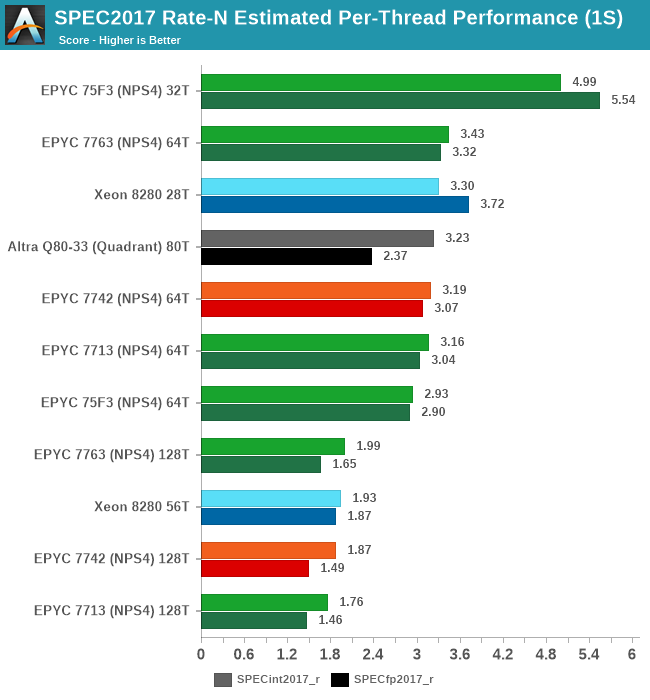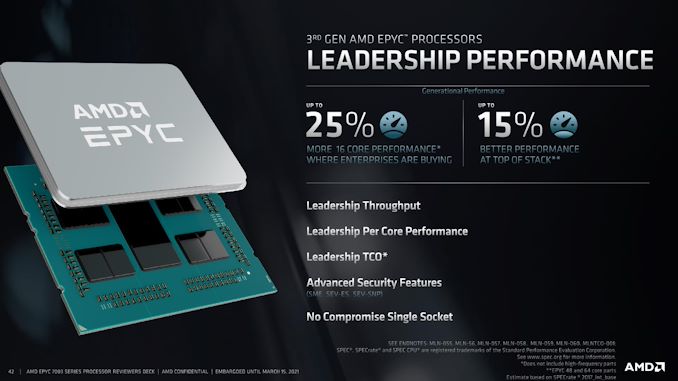AMD 3rd Gen EPYC Milan Review: A Peak vs Per Core Performance Balance
by Dr. Ian Cutress & Andrei Frumusanu on March 15, 2021 11:00 AM ESTDisclaimer June 25th: The benchmark figures in this review have been superseded by our second follow-up Milan review article, where we observe improved performance figures on a production platform compared to AMD’s reference system in this piece.
SPEC - Per-Core Win for "F"-Series 75F3
A metric that is actually more interesting than isolated single-thread performance, is actually per-thread performance in a fully loaded system. This actually is a measurement and benchmark figure that would greatly interest enterprises and customers which are running software or workloads that are possibly licensed on a per-core basis, or simply workloads that require a certain level of per-thread service level agreement in terms of performance.
It’s precisely this market that AMD is trying to target with its new “F”-series of processors, and this is where the new 75F3 comes into play. With 32 cores, 4 cores per chiplet with the full 256MB of L3 cache, and a base frequency of 2.95GHz, boosting up to 4.0GHz at a default 280W TDP, is the chip is squeezing out the maximum per-core performance while still offering a massive amount of multi-threaded performance.

At full load, this ends up with a massive per-thread performance leadership on the part of the 75F3, landing 45% ahead of the 7763 and 51% ahead of the Intel Xeon 8280.
It’s to be noted that limiting the thread count of the higher core-count SKUs will also result in a better per-thread performance metric, for example running a 7713 with only 32 threads will result in a SPECint2017 estimated score of 4.30 – the 75F3 still has a 16% advantage there even though its boost clock is only 8.8% higher at the peak – meaning the 75F3 is achieving higher effective frequencies. Unfortunately, we didn’t have enough time to do the same experiment on the equal 280W 7763 part.
AMD discloses that the biggest generational gains for the Milan stack is found in the lower core-count models, where for example the 7313 and the 7343 outperforms the 7282 and 7302 by 25%. Reason for this is that for example the new 7313 features double the L3 cache, and all the new CPUs are boosting higher with respectively higher TDPs, increasing to 150/190W from 120/155W, as well as landing in at +50% higher price points when comparing generation to generation.











120 Comments
View All Comments
MenhirMike - Monday, March 15, 2021 - link
Ampere Altra *Server* that is. I'd love to get a system with the CPU, but priced in the realm of "Let's tinker with it and try it out" along with "Let's not cool it with 15000+rpm 40mm fans".kgardas - Monday, March 15, 2021 - link
Avantek provides some workstation as a more silent solution: https://www.avantek.co.uk/ampere-emag-arm-workstat... -- I'll leave price options to you...MenhirMike - Tuesday, March 16, 2021 - link
Yeah, but that Avantek is old tech: https://www.anandtech.com/show/15733/ampere-emag-s...Calin - Tuesday, March 16, 2021 - link
"ARM on the server is actually gaining foothold"They have won some niches and are expanding from there.
I don't think they have enough fab capacity to build all the processors they could sell (especially as AMD is capacity-limited and Intel is - apparently - yield limited).
Spunjji - Friday, March 19, 2021 - link
In the intervening 7 years, it has only become more obvious as an eventuality. Unless you're denying the existence of AWS' serious investment into that ecosystem...Wilco1 - Sunday, March 21, 2021 - link
Yes, Graviton is already 14% of AWS and still growing fast.prisonerX - Monday, March 15, 2021 - link
ARM prediction is probably good, but not with NVIDIA, they're unlikely to be approved.Crazyeyeskillah - Monday, March 15, 2021 - link
Nvidia will have no impact on arm improvements. They merely seek to take Intel and AMD out of the equation by pairing Custom Arm servers with their gpus.Yojimbo - Monday, March 15, 2021 - link
NVIDIA can have servers with custom ARM chips without buying ARM.Yojimbo - Monday, March 15, 2021 - link
And by pointing this out I mean that NVIDIA have no intention of taking Intel or AMD out of the equation. They want their GPUs to be used anywhere with any CPU. The problem is Intel and AMD potentially taking NVIDIA's GPUs out of the equation.